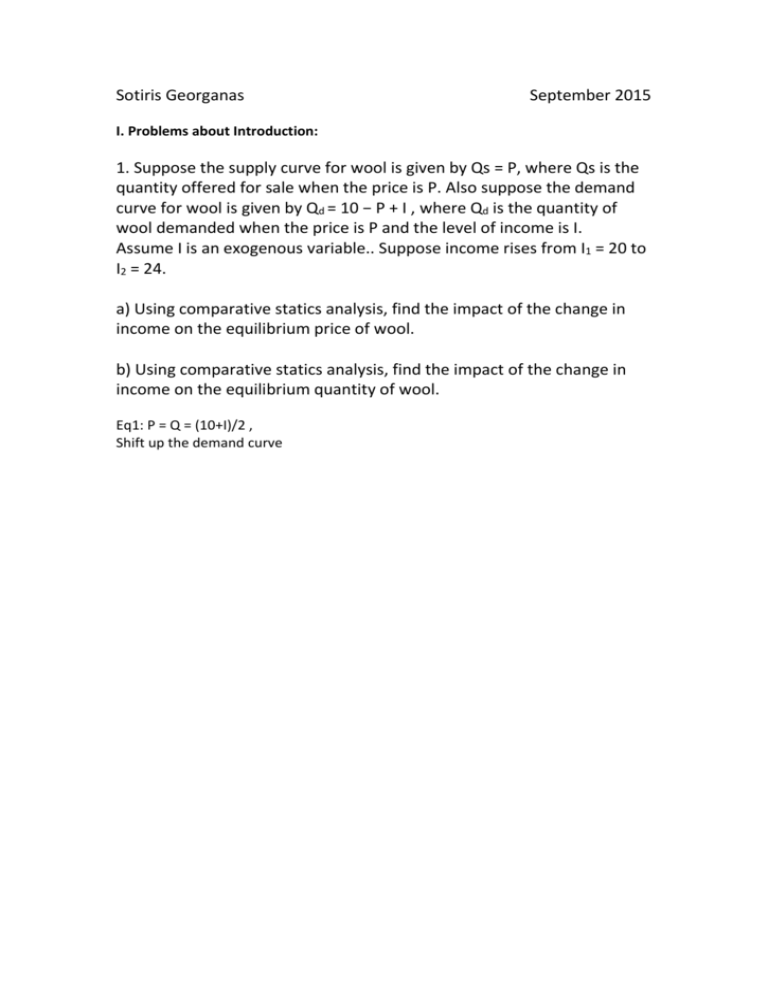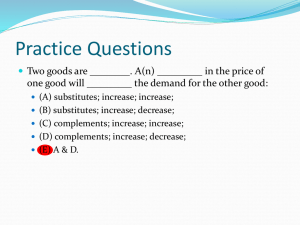Problems With Solutions
advertisement

Sotiris Georganas September 2015 I. Problems about Introduction: 1. Suppose the supply curve for wool is given by Qs = P, where Qs is the quantity offered for sale when the price is P. Also suppose the demand curve for wool is given by Qd = 10 − P + I , where Qd is the quantity of wool demanded when the price is P and the level of income is I. Assume I is an exogenous variable.. Suppose income rises from I1 = 20 to I2 = 24. a) Using comparative statics analysis, find the impact of the change in income on the equilibrium price of wool. b) Using comparative statics analysis, find the impact of the change in income on the equilibrium quantity of wool. Eq1: P = Q = (10+I)/2 , Shift up the demand curve II. Problems about Demand and Supply 1. Suppose price is initially $5, and the corresponding quantity demanded is 1000 units. Suppose, too, that if the price rises to $5.75, the quantity demanded will fall to 800 units. What is the price elasticity of demand over this region of the demand curve? Is demand elastic or inelastic? 2. Suppose a constant elasticity demand curve is given by the formula Q = 200P−1/2 What is the price elasticity of demand? 3. Suppose a linear demand curve is given by the formula Q = 400 − 10P. What is the price elasticity of demand at P = 30? At P = 10? III Problem set Consumer Choice Theory 1. Let’s look at a utility function that satisfies the assumptions that more is better and that marginal utilities are diminishing. Suppose a consumer’s preferences between food and clothing can be represented by the utility function U = √xy, where x measures the number of units of food and y the number of units of Clothing. (a) Show that a consumer with this utility function believes that more is better for each good. (b) Show that the marginal utility of food is diminishing and that the marginal utility of clothing is diminishing. (a) By examining the utility function, we can see that U increases whenever x or y increases. This means that the consumer likes more of each good. Note that we can also see that more is better for each good by looking at the marginal utilities MUx and MUy , which must always be positive because the square roots of x and y must always be positive (all square roots are positive numbers). This means the consumer’s utility always increases when he purchases more food and/or clothing. Also, for both at the same time: (x,y)>=(z,w) u() etc The marginal utilities for x and y are expressed by the following equations: MUx = √y/(2√x ) MUy = √x/(2√y ) (b) In both marginal utility functions, as the value of the denominator increases (holding the numerator constant), the marginal utility diminishes. Thus, MUx and MUy are both diminishing. Also: second derivative <0 2. Suppose a consumer has preferences between two goods that can be represented by the utility function U = xy. For this utility function, MUx = y and MUy = x. (a) On a graph, draw the indifference curve associated with the utility level U1 = 128. Then answer the following questions: 1. Does the indifference curve intersect either axis? 2. Does the shape of the indifference curve indicate that MRSx, y is diminishing? (b) On the same graph draw a second indifference curve, U2 = 200. Show how MRSx, y depends on x and y, and use this information to determine if MRSx, y is diminishing for this utility function. (a) To draw the indifference curve U1 = 128 for the utility function U = xy, we plot points where xy = 128—for example, point G (x = 8, y = 16), point H(x = 16, y = 8), and point I (x = 32, y = 4)—and then connect these points with a smooth line. The figure below shows this indifference curve. Can the indifference curve U1 intersect either axis? Since U1 is positive, x and y must both be positive (assuming the consumer is buying positive amounts of both goods). If U1 intersected the x axis, the value of y at that point would be zero; similarly, if U1 intersected the y axis, the value of x at that point would be zero. If either x or y were zero, the value of U1 would also be zero, not 128. Therefore, the indifference curve U1 cannot intersect either axis. Is MRSx, y diminishing for U1? Figure 3.10 shows that U1 is bowed in toward the origin; therefore, MRSx, y is diminishing for U1. (b) Figure 3.10 also shows the indifference curve U2 = 200, which lies up and to the right of U1 = 128. Note that both MUx and MUy are positive whenever the consumer has positive amounts of x and y. Therefore, indifference curves will be negatively sloped. This means that as the consumer increases x along an indifference curve, y must decrease. Since MRSx, y = MUx/MUy = y/x, as we move along the indifference curve by increasing x and decreasing y, MRSx, y = y/x will decrease. So MRSx, y depends on x and y, and we have diminishing marginal rate of substitution of x for y. 3 a) Nick has a preference ordering that can be represented by the utility function u(x,y)=xy2. What is the general expression for Nick’s Marginal Rate of Substitution between x and y? [2 points] What is the value of Nick’s MRS if he is consuming a bundle which is on the indifference curve for which u(x,y)=32, and he is consuming 4 units of y? a) (1) MRS=(du/dx)/(du/dy)=y2/2xy=y/2x. (2) u(x,y)=xy2=32 and y=4 x=32/42=32/16=2 MRS=4/(2*2)=1 4.Finding a Demand Curve (No Corner Points) A consumer purchases two goods, food and clothing. The utility function is U(x,y)=xy, where x denotes the amount of food consumed and y the amount of clothing. The marginal utilities are MUx = y and MUy = x. The price of food is Px , the price of clothing is Py , and income is I. (a) Show that the equation for the demand curve for food is x = I/(2P x ). (b) Is food a normal good? Draw D1, the consumer’s demand curve for food when the level of income is I = $120. Draw D2, the demand curve when I = $200. (a) In Learning-By-Doing Exercise 3.3, we learned that the indifference curves for the utility function U(x, y) = xy are bowed in toward the origin and do not intersect the axes. So any optimal basket must be interior, that is, the consumer buys positive amounts of both food and clothing. How do we determine the optimal choice of food? We know that an interior optimum must satisfy two conditions: • An optimal basket will be on the budget line. Pxx + Py y = I. Since the optimum is interior, the tangency condition, equation (4.3), must also hold: MUx/MUy = Px/Py , or, with the marginal utilities given, y/x = Px/Py , or y = (Px/Py )x. We can now solve for x by substituting y = (Px/Py )x into the equation for the budget line Pxx + Py y = I . This gives us: or x = I/(2Px ). It’s normal because the derivative of X wrt I is >0 This is the equation of the demand curve for food. Given the consumer’s income and the price of food, we can easily find the quantity of food the consumer will purchase. (b) If income is $120, the equation of the demand curve for food D1 will be x = 120/ (2Px ) = 60/Px. We can plot points on the demand curve, as we have done in Figure 5.5. An increase in income to $200 shifts the demand curve rightward to D2, with the equation x = 200/(2Px ) = 100/Px . Thus, food is a normal good. 5. Finding a Demand Curve (with a Corner Point Solution) A consumer purchases two goods, food and clothing. He has the utility function U(x, y) = xy + 10x, where x denotes the amount of food consumed and y the amount of clothing. The marginal utilities are MUx = y + 10 and MUy = x. The consumer’s income is $100, and the price of food is $1. The price of clothing is Py . Problem Show that the equation for the consumer’s demand curve for clothing is Use this equation to fill in the following table to show how much clothing he will purchase at each price of clothing (these are points on his demand curve): Solution In Learning-By-Doing Exercise 4.3, we learned that the indifference curves for the utility function U(x, y) = xy + 10x are bowed in toward the origin. They also intersect the x axis, since the consumer could have a positive level of utility with purchases of food (x > 0) but no purchases of clothing (y = 0). So he might not buy any clothing (i.e., choose a corner point) if the price of clothing is too high. How do we determine the consumer’s optimal choice of clothing? If he is at an interior optimum, we know that his optimal basket will be on the budget line. This means that equation (4.1) must hold with the price of x and income given: x + Py y = 100. At an interior optimum, the tangency condition as expressed in equation (4.4) must also hold: MUx/MUy = Px/Py , or with the marginal utilities given, ( y + 10)/x = 1/Py , or more simply, x = Py y + 10Py . We can now solve for y by substituting x = Py y + 10Py into the equation for the budget line x + Py y = 100. This gives us 2Py y + 10Py = 100, or y = (100 − 10Py )/(2Py). Note that the value of this equation for the consumer’s demand curve for clothing is positive when Py < 10. But if Py ≥ 10, then 100 − 10Py is zero or negative, and the consumer will demand no clothing (in effect, y = 0 when Py ≥ 10, since the consumer can’t demand negative amounts of clothing). In other words, when Py ≥ 10 the consumer will be at a corner point at which he buys only food. Using the equation for the demand curve, we can complete the table as follows: Problems set Theory of the Firm 0. The production function is Q(K,L)=K0.5 L0.5. Compute: marginal product of labour, average product of labour. Do we have increasing/decreasing marginal returns to labour? 1. Deriving the Equation of an Isoquant (a) Consider the production function whose equation is given by the formula Q = √KL. What is the equation of the isoquant corresponding to Q = 20? (b) For the same production function, what is the general equation of an isoquant, corresponding to any level of output Q? Solution (a) The Q = 20 isoquant represents all of the combinations of labor and capital that allow the firm to produce 20 units of output. For this isoquant, the production function satisfies the following equation: 20 =√KL To find the equation of the 20-unit isoquant, we solve this equation for K in terms of L. The easiest way to do this is to square each side of equation (6.4) and then solve for K in terms of L. Doing this yields K = 400/L. This is the equation of the 20-unit isoquant. (b) In the general case, we begin with the production function itself: Q = √KL. To find the general equation of an isoquant, we again square each side and solve for K in terms of L. Doing this yields K = Q2/L. (If you substitute Q = 20 into this equation, you get the equation of the 20unit isoquant that we solved for above.) 2. Relating the Marginal Rate of Technical Substitution to Marginal Products At first glance, you might think that when a production function has a diminishing marginal rate of technical substitution of labor for capital, it must also have diminishing marginal products of capital and labor. Show that this is not true, using the production function Q = KL, with the corresponding marginal products MPK = L and MPL = K. First, note that MRTSL,K = MPL/MPK = K/L, which diminishes as L increases and K falls as we move along an isoquant. So the marginal rate of technical substitution of labor for capital is diminishing. However, the marginal product of capitalMPK is constant (not diminishing) as K increases (remember, the amount of labor is held fixed when we measure MPK). Similarly, the marginal product of labor is constant (again, because the amount of capital is held fixed when we measure MPL). This exercise demonstrates that it is possible to have a diminishing marginal rate of technical substitution even though both of the marginal products are constant. The distinction is that in analyzing MRTSL,K, we move along an isoquant, while in analyzing MPL and MPK, total output can change. 1.- Consider a firm that produces using the technology: . a) Derive the (long-run) cost-minimizing input demand functions for this firm, as well as the minimum cost function. If input prices were w=1 and v=1, how many units of each input would the firm use to produce 10 units of output? How much would it cost? What happens if the cost of capital doubles? Explain. b) Now derive and graph the (long-run) average and marginal cost functions. What can you say about the Returns to Scale properties of the technology, based on these two functions? 1. a. (1) Cost-minimizing input demand functions: K = q, L = q / 5 (2) Minimum cost function: TC = wL + vK = w(q/5) + vq (3) If w = 1, v = 1, q = 10, K = 10, L = 10/5 = 2 (4) If w = 1, v = 1, q = 10, TC = 1×2 + 1×10 = 12 (5) If cost of capital doubles, i.e. v = 2, K and L will be unchanged, i.e. K = 10, L = 10/5 = 2 But TC = 1×2 + 2×10 = 22. Given q = min (5L, K ), K and L have no substitute effect for each other. So when v changes, the amount of K and L will not change, only the TC will change. b. (1) AC = TC/q = [w(q/5) + vq]/q = w/5 + v (2) MC = dTC/dq = d[w(q/5) + vq]/dq = w/5 + v (3) AC = MC = w/5 + v is a constant independent of q. So the technology exhibits constant returns to scale. 1.- Universal Widget produces high-quality widgets using the production function: . In the short run, Universal Widget has 2 units of capital (K=2). Labour costs are $2 per unit (w=2) and capital costs are $1 per unit (v=1). a) What is Universal Widget’s short-run total cost of producing widgets? What are its short-run average costs and its short-run marginal costs? [5 points] b) Suppose that widgets are sold in a competitive market at unit price P. What is Universal Widget’s short-run supply function? [5 points] a) Since q = L1/2K2 and the level of capital is fixed, K*=2, we have that there is only one possible level of labour that allows Universal Widget to produce q widgets, L*=(q/22)2=q2/16. The short-run total cost function is substituting the two levels into STC, STC=vK+wL = 1×2 + 2(q2/16) = 2 + q2/8. The short-run average cost function is, thus, SAC = STC/q = 2/q + q/8 and the short-run marginal cost function is SMC=dSTC/dq = 2q/8 = q/4. b) The firm is going to maximize profits when P = SMC = q/4. Therefore the short run supply curve is q = 4P. Since marginal costs are always increasing and the average variable costs are below the marginal costs, SAVC=q/8 < q/4 = SMC, the supply curve is q=4P.





